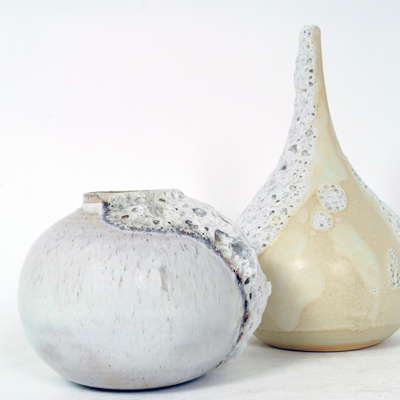2020 AWARD WINNER | Manchester School of Art
Posted on - 9th September 2020

Annie Crowe | BA (Hons) Three Dimensional Design
Manchester School of Art
Tell us about yourself, your work, and your career path so far.
I am a Manchester based sculptural ceramicist, currently working out of my makeshift home studio, having just graduated from Manchester School of Art. I am enjoying and embracing the learning curve of working independently and establishing my place in the ceramic world.
I begin most of my work on the throwing wheel, constructing simple yet refined forms, that act as a canvas for exciting, haptic glazes. Texture is a strong focus in my work. I spend a lot of my time testing, adapting and developing glazes to create unique and experimental outcomes within the kiln firing process, rejecting the traditional and functional purposes of glaze. My practice seeks to find harmony between elegance and imperfection through the carefully considered form and glaze choices.
I try to work collaboratively with my materials and honour the making process, guiding the clay as I throw, but not forcing it. I measure and mix the glaze recipes precisely, then allow the chemical reactions in the kiln to determine the end results. Through incorporating ingredients such as Silicone Carbine bubbles, peeling and pronounced crazing form, growing, expanding and transforming on the surfaces of the ceramic body.
I have explored ceramic 3D printing, spending a semester on placement followed by a scholarship building a Delta ceramic printer with Dr CJ O’Neill. I then partook in a live installation titled Mapping Networks at the British Ceramics Biennial 2019, printing clay sculptures of the public’s portraits. This was valuable experience and insight but confirmed my passion lay with the traditional and tactile process of handmaking. During the third year of my degree course, I committed my time to throwing and learning about glaze chemistry.
Describe your first encounter with clay?
Having trained in painting and sculpture prior to my degree, I didn’t discover ceramics until starting university. I began to feel disconnected to my fine art based practice in my first year and decided to explore new mediums to work in. I wandered into the ceramics room and began with hand building, and quickly became fixated by the meditative, rhythmic process and smooth, tactile feeling of the clay in my hands. From here I discovered slip casting and then throwing. I enjoyed the challenge and self-discipline that came with these processes and continued to push my technical abilities throughout my degree, realising that practice was fundamental. I never really left the ceramics room after this!
Why did you choose ceramics?
Ceramics can be challenging, disappointing and frustrating, which is what makes it the most rewarding medium to work in. It has taught me a great deal of patience and resilience, and I have learned to celebrate imperfections and accidents because of the unforeseen nature of it as a medium. My work rarely turns out exactly as planned but can often result in an unanticipated outcome that I really like. This element of chance keeps the process exciting and engaging (if a little nerve-racking at times!)
Clay offers me a connection to the natural world like no other material could. There is also something very inspiring and humbling about working with a substance that has such a rich and diverse history across so many cultures, and has played a role in humanity for tens of thousands of years.
Where do you find inspiration? Places, people, objects, music...
I am influenced by the process of decay, specifically in the natural environment. There is a fascination in the constant transitioning states of natural landscapes. Haptic sensations and unique patterns occur on surfaces spontaneously over time as materials break down and transform through natural weathering and impacts of time.
Living in a starkly contrasting city environment, I cherish time spent in nature. I find trips to the British coast inspiring and grounding, embracing climactic changes and atmosphere. I take photographs, make sketches and collect small unique pebbles or other weather-worn objects. These then return to the studio with me as souvenirs of an excursion and often provoke new ideas for glazes and colour pallets. I aim to embody the first-hand experience of location within my work and capture the sensory experience that was evoked, making it an incredibly personal process.
What are the tools of your trade that you can't do without?
After my final year at university, my potter’s wheel has very much become an extension of myself, after so many days spent throwing. The Mudtools standard green cutting wire is a toolbox must have for me - it is ideal for removing work from bats seamlessly without hurting my hands. A sponge-on-a-stick always comes in handy to get the water out of the hard to reach bases of pieces when throwing. Last but defiantly not least, a good quality mask for glaze mixing!
What is a typical day in the studio like?
My days tend to vary, depending on what I am currently working on. I try to get into the workshop early as I have the most energy in the mornings. If it’s a ‘making’ day, I will sit and look over my sketches and notes. I tend to explore new ideas best by practical making rather than on paper, so I will experiment with forms, having no expectations. After establishing what I want to throw, I will work out the dimensions and how much clay I need, then proceed to wedge enough clay. I try to throw for as long as possible, until my arms and back tell me to stop!
Usually, by the afternoon, the kiln that had been turned on a couple of days before has cooled enough from a high fire glaze temperature to open. I try to get a few new test tiles in every firing to keep momentum and progression of new ideas going. After years of glaze testing, I still get very excited to crack the kiln door and have that first peek at the test tile results! From here I will take the new samples and analyse them against my notes and examine/research what adjustments to the recipe may be needed, so I can try to get closer to my desired outcome. Sometimes I will be exploring new avenues as a result of unexpected findings.
What do the next 12 months have in store for you?
With so much uncertainty right now, this is hard to say. I am currently in the process of finding a shared studio space, that will enable me to make bigger and more challenging work and start to seek exhibition opportunities. I have a few commissions I am getting started on over the coming weeks and am learning how to work to a brief and gaining experience of liaising with a client.
Beyond this, I hope to obtain some work experience and intern for a successful sculptural ceramicist to gain knowledge and understanding of how to transition to my practice to my fulltime career in the future.
What advice do you have for those currently studying ceramics in further education?
Utilise the facilities and opportunities that are made available to you throughout your studies - this whole process is the building blocks for your professional practice.
Spend as many hours making as you can and don’t stop challenging yourself to learn and improve, both on a practical and conceptual front.
Don’t let failure set you back. Accept it and analyse/ learn from unsuccessful work – it will make the successes even more worthwhile.
Always approach a new project with an open mind, you may have a plan of what you want to make, but the clay will often have other ideas!
Keep a personal notebook and document everything you do in detail, especially successful glaze recipes. it will come to be invaluable in the future.
Most importantly, ask questions. The technical staff around you are a hive of information and have invaluable knowledge and experience that you will not have access to after graduating.


